|
80x5 -
240x3 -
240x4 -
320x1 -
320x2 -
320x3 -
640x1 -
640x2
Set display option above.
Click on
images to enlarge. |
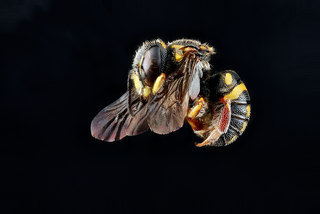
© Copyright source/photographer
· 9
Anthidiellum notatum, -male, -side 2012-07-13-17.00.25 |
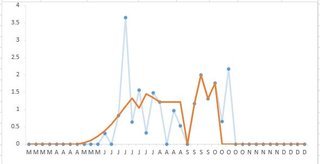
© Copyright source/photographer
· 9
Anthidiellum notatum, Mid-Atlantic Phenology |
|
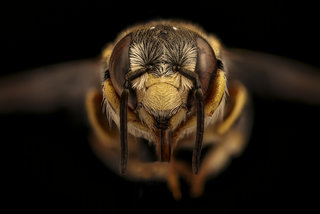
© Copyright source/photographer
· 7
Anthidiellum notatum robertsoni, m, face, Yolo, CA |
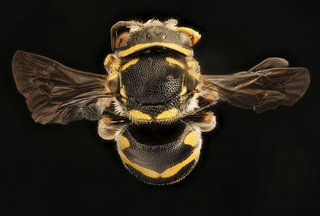
© Copyright source/photographer
· 7
Anthidiellum notatum, m, back, Yolo, CA |
|
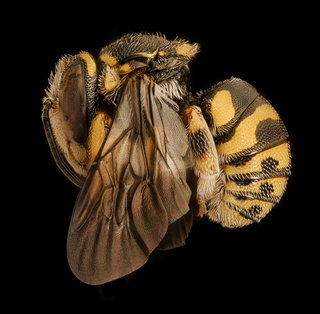
© Copyright source/photographer
· 7
Anthidiellum notatum, m, left, Yolo, CA |
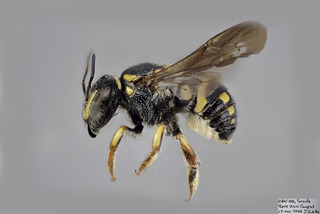
© Copyright Laurence Packer 2014
· 7
Anthidiellum notatum FEM CFP comp |
|
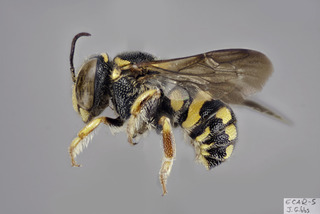
© Copyright Laurence Packer 2014
· 7
Anthidiellum notatum MALE CFP comp |
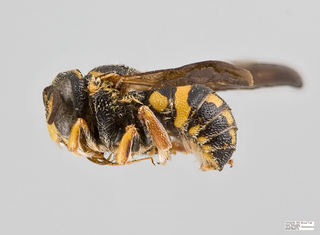
© Copyright Laurence Packer 2014
· 7
Anthidiellum notatum Male |
|
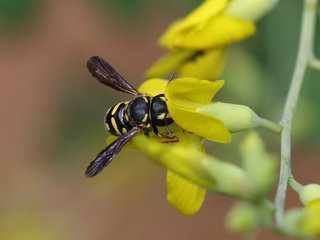
Michael Veit · 6
Anthidiellum notatum, f Baptisi -- |
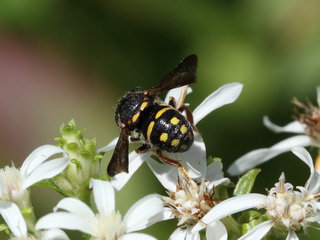
Michael Veit · 6
Anthidiellum notatum, f on Aster -- |
|
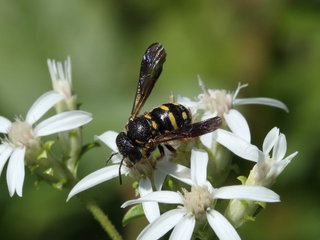
Michael Veit · 6
Anthidiellum notatum, f on Aster -- |
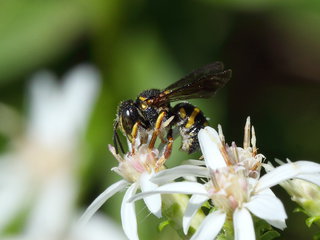
Michael Veit · 6
Anthidiellum notatum, f on Aster -- |
|
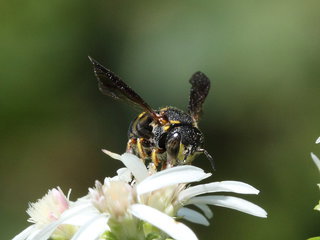
Michael Veit · 6
Anthidiellum notatum, f on Aster -- |
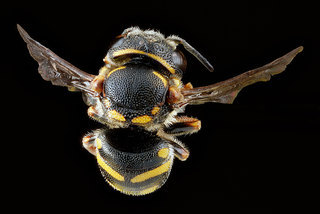
© Copyright source/photographer
· 5
Anthidiellum notatum, -male, -back 2012-07-13-16.39.15 |
|
Overview |
Reprinted with permission from: Mitchell, T.B. 1962 Bees of the Eastern United States. North Carolina Agricultural Experiment Station Technical Bulletin No. 152.
Anthidiellum notatum notatum
FEMALE—Length 8 mm.; black, with yellow maculations; clypeus in large part, and adjacent margin of supraclypeal area, yellow; lateral facial maculae yellow, extending broadly nearly to top of eye; posterior margin of vertex with a yellow band terminating just above top of eye; tubercles and adjacent margin of scutum broadly yellow, the median third or more of this margin black; axillae, an adjacent small spot at lower lateral angle of scutum, and scutellum in large part, yellow; median, anterior area of scutellum black; mandibles, apical margin of clypeus, entire cheeks and pleura, black; legs black basally, tibiae in large part yellow, hind pair becoming ferruginous toward apex, tarsi largely brownish-ferruginous, but front tarsi somewhat yellowish; basal abdominal tergum black, with a pair of rather short but broad maculae at each extreme side, tergum 2 with a pair of elongate, slightly curved, basal, transverse, yellow bands which nearly meet at midline; terga 3-5 with rather widely separated, rectangular, yellow blotches; face somewhat longer than distance between eyes above; eyes somewhat convergent below; lateral ocelli considerably nearer margin of vertex than to eyes; posterior margin of vertex subcarinate; cheeks very much narrower than eyes; clypeus somewhat convex, apical margin slightly thickened, only slightly out-curved; mandibles robust, quite distinctly 4-dentate, the teeth low; tegulae reddish-testaceous, with a yellow, anterior blotch, very minutely and quite closely punctate; wings rather deeply infuscated, veins piceous; front and middle spurs very short, yellowish-hyaline, hind spurs dull brownish-testaceous, nearly as long as the basitarsi; pubescence extremely short, thin, entirely pale, hardly evident on dorsum of thorax and on abdominal terga, ventral scopa entirely whitish; punctures quite coarse, deep and distinct, quite close below ocelli, closely crowded on cheeks, area between ocelli swollen and impunctate, with a deep, median impression; punctures very coarse and quite close on pleura, scutellum and axillae, somewhat less coarse and more definitely separated but still quite close on scutum; punctures distinct, deep and rather close on abdominal terga medially, becoming more coarse and close at extreme sides, apical margins narrowly shining and impunctate, depressed toward extreme sides; tergum 6 densely and finely rugoso-punctate, surface rather deeply impressed just before apical margin.
MALE—Length 7-8 mm.; black, with yellow maculations; outer face of mandibles, entire clypeus, lower and lateral areas of supraclypeal area and adjacent, lateral, facial maculae terminating rather narrowly near upper part of eyes, yellow; posterior margin of vertex narrowly yellow, ending just above top of eye; tubercles, an anterior spot on each tegula, axillae in large part, and scutellum posteriorly, yellow; anterior margin of scutum adjacent to tubercle with a yellow band, median third or more of this margin black; pleura, cheeks and upper part of face black; basal abdominal tergum black, with large yellow blotches at each extreme side, tergum 2 with transverse, slightly curved, sub-basal, yellow maculations which nearly meet medially, terga 3-5 with submedian, rather widely separated, rectangular blotches and small, yellow maculations at extreme sides; face considerably longer than distance between eyes above; eyes convergent below; lateral ocelli somewhat nearer margin of vertex than to eyes; cheeks very much narrower than eyes; clypeus slightly convex, apical margin nearly straight; mandibles distinctly 3-dentate, teeth black; tegulae reddish, with minute and quite close punctures; wings deeply infuscated, veins piceous; legs in large part ferruginous, but front and mid tibiae on outer face, and basal spot on hind tibiae, yellow; all basitarsi yellow, the more apical tarsal segments ferruginous; spurs yellowish, front and mid pair very short, more hyaline, hind pair somewhat more elongate but not approaching basitarsi in length; punctures coarse, deep and distinct, quite close between ocelli and antennae, somewhat more widely separated below, densely crowded on cheeks; area between ocelli swollen and impunctate but with a deep, median impression; punctures coarse and distinct, not crowded on pleura, axillae and scutellum, the scutum shining, punctures well separated in central part of disc posteriorly, becoming finer and closer anteriorly; basal tergum closely, deeply and distinctly punctate across entire disc, punctures on terga 2-5 slightly more widely separated and coarse, apical margins of discs narrowly impunctate, somewhat reddened, becoming depressed toward extreme sides; tergum 6 black except for the yellowish, lateral margins and narrowly along posterior margin, with a pair of low, submedian, apical protuberances; tergum 7 broad and quite short, slightly emarginate medially, coarsely and quite closely punctate; sterna 1-4 largely exposed, with rather elongate and thin, whitish pubescence; sterna 5-8 largely retracted, form as shown (fig. 6); gonostyli of genital armature elongate and quite narrow, much exceeding penis valves at apex.
DISTRIBUTION—Illinois to Massachusetts, south to Florida and Mississippi, April to September.
FLOWER RECORDS—Afzelia, Baptisia, Chrysopsis, Desmodium, Erigeron, Eu patorium, Galactia, Helianthus, Melilotus, Monarda, Phaseolus, Psoralea Solidago and Trifolium.
Anthidiellum notatum boreale
The material available for study of this form is very inadequate. The holotype male has been seen. It is very similar to typical notatum, but the axillae have a very much reduced maculation, being almost entirely black. A female at hand, from northern Illinois may represent that sex for this form. It differs from the typical notatum female in the reduction of the swollen, impunctate area between the ocelli, this area being nearly flat and with a few, scattered punctures; the clypeus and axillae in this specimen are entirely black, otherwise the maculation is very similar to that of notatum.
DISTRIBUTION—Nebraska and Illinois.
FLOWER RECORD—Robertson (1929) records this subspecies on Verbena stricta.
Anthidiellum notatum rufimaculatum
This form is nearly or quite identical with typical notatum structurally, differing chiefly in the color of the maculated areas, which are ferruginous, with entirely ferruginous legs. The color differences for the two sexes are as follows:
FEMALE—Lateral areas on clypeus, adjacent margin of supraclypeal area, and lateral facial maculae ending broadly nearer upper end of eye, ferruginous; posterior margin of vertex with a broad ferruginous band, extending down to upper third of eye on cheeks; scape, pedicel and segments 1 and 2 of flagellum reddish-testaceous, the more apical segments piceous; tubercles ferruginous and adjacent margin of scutum quite broadly ferruginous, extending down each side nearly to axillae; axillae entirely, and scutellum in large part, ferruginous; tegulae reddish-testaceous; pleura and propodeum entirely black; basal half of abdominal tergum 1 entirely ferruginous, •apical half across central portion of disc, black; tergum 2 largely ferruginous basally, but the curved and slightly separated, more yellowish maculae faintly visible within the ferruginous area; terga 3-5 with submedian, rather widely separated, rectangular, ferruginous blotches, lateral margins of these terga entirely black.
MALE—Clypeus and mandibles, except teeth, entirely yellow, lateral facial maculae yellow in large part, but terminated near top of eye by a more ferruginous area, and supraclypeal area yellow in large part, but tinged with ferruginous above; posterior margin of vertex broadly ferruginous, the band reaching upper third of eye on cheeks; antennae largely reddish-testaceous, but becoming somewhat more brownish apically; tegulae yellowish-ferruginous, adjacent area of scutum rather broadly ferruginous, extending down each side nearly to axillae; axillae and scutellum entirely ferruginous; pleura entirely black, posterior face of propodeum with a pair of extensive, yellow blotches; legs yellowish-ferruginous, but basitarsi more definitely yellowish on outer face; basal abdominal tergum almost entirely ferruginous, with a subapical, narrow, blackish band extending nearly from one side to the other; tergum 2 with a somewhat similar, slightly broader and more conspicuous dark band; terga 3-5 with submedian rather widely separated, rectangular blotches, and the extreme lateral, tuberculate margins of each tergum ferruginous; tergum 6 black medially, ferruginous laterally and tergum 7 almost entirely ferruginous.
DISTRIBUTION—Florida, March to December.
FLOWER RECORD—Rhus.
|
|
|
Identification | |
Note the existence of the 2 or 3 color variations of this species. Anthidiellum notatum rufimaculatum is a largely deep south subspecies and with the colors shifting from bright yellow to deep orange-red. Structural features appear to be the same.
Extracted from THE POLLEN-COLLECTING BEES OF THE ANTHIDIINI OF CALIFORNIA (Hymenoptera: Megachilidae) by Grigarick A., A. (1968).
Anthidiellum notatum is represented by five sub¬species extending from the east to the west coast of the United States and from British Columbia into Mexico. The subspecies are separated primarily on the basis of color and somewhat on size, although there is considerable variation in both of these char¬acteristics. A. n. robertsoni differs from the other subspecies by lacking prominent reddish-brown markings. The yellow maculations of n. robertsoni are generally the most extensive of the species, al¬though this varies and these patterns are quite reduced on specimens from Mexico. The maculations of n. rufimaculatum from Florida are nearly entirely reddish-brown while this red coloration is limited to the legs of n. gilense in the southwestern United States. The nominate subspecies usually has the reddish-brown markings in conjunction with the yel¬low pattern of most of the body and extends from the east coast to the midwest. A. n. boreale has the same color pattern as n. notatum, but the male bears a medium longitudinal carina on the last two meta-somal terga. Such a carina has been observed on some specimens of n. notatum and most specimens of n. robertsoni. A. n. robertsoni tends to be the smallest of the subspecies.
The males of n. robertsoni are easily distinguished
from those of ehrhorni by tergum VII and the pre¬sence of pubescence on the forelegs twice as long as the leg width on n. robertsoni but subequal in length for ehrhorni.
A. n. robertsoni is widely distributed throughout most of California, from sea level to nearly 7,000 feet. Collections of 435 males and 267 females have been observed from the state.
This subspecies has been collected on members of 28 genera in 13 plant families, with one-third of the visitations being on genera in the Compositae. The most frequent visits were recorded in the Legumi-nosae and Polygonaceae, particularly on species of the genera Lotus and Eriogonum. The nest of n. robertsoni was first reported from British Columbia by Leech in 1947 as a single cell on the flat under¬side of a piece of douglas fir wood. It was 13 mm long with an apical spike, appeared somewhat warty. and was greenish black with a vitreous surface. The nest and emerged bee were drawn. Leech also col¬lected a single-celled nest of n. robertsoni attached to the flat surface of a chip of wood from Lake County, California (fig. 228). The resin nest is dark brown, shiny, and relatively smooth, although magnification reveals a fine granular surface and several wartlike irregularities. The cell is approximately 19 mm long with the apical projection broken.
First instar meloid larvae of the genus Ncmcg-natha were found attached to the pubescence of a male of n, robertsoni collected at Blairsden Plumas Co., California, VII-10-61, by J. Buckett
|
|
|
Names | |
|
|
| Supported by | |
Updated: 2024-04-23 18:48:05 gmt
|